Anybody who has been working remotely must have already discovered that a reliable pair of headphones is an essential part of the home office. The headphones come in real handy when you are taking Zoom calls in a nearby room or around loud kids. The best headphones for working from home can help isolate you from all these disruptive forces and help you focus on the task at hand.
Headphones used for working should offer top-notch sound quality and comfort (since you’ll be wearing them for hours on end). They should also include excellent communications features for making voice calls, including any sort of video chats. Good noise reduction is key, as is being able to hear your own voice in the headphones as you talk (so you don’t end up shouting). Good battery life also helps. Finally, multipoint Bluetooth pairing, which allows you to switch easily between two devices, is another noteworthy feature in the home-office environment.
You may specifically be looking for a headset or headphones designed to work with Unified Communications applications and certified for Skype for Business, optimized for Microsoft Lync and suitable for softphones from Cisco, Avaya and Skype. I’ve included some UC headphones on this list, but the majority of these are mainstream consumer headphones that also work well on the go. We have curated this list of the best headphones for work as a tool to help you see which features each brings to the table so that you can decide which fit is best for you.
Read more: Best Cheap VPN: Three Options for Working From Home

 \n ","topic":"","ttag":"","variant":"","viewguid":"","event":"listicle|image|1","correlationId":"","_destCat":"https:\/\/www.bose.com\/en_us\/products\/headphones\/noise_cancelling_headphones\/quietcomfort-headphones-45.html","productName":"Bose QuietComfort 45 – headphones with mic","formatType":"IMAGE","location":"LIST","position":1,"sku":"866724-0100","dwLinkTag":"article-body|listicle|image","selector":"#article-body #listicle-ee6e2f6e-c06a-4707-8fe9-e7661ee498b1 .itemImage"}}” rel=”noopener nofollow” target=”_blank”>
\n ","topic":"","ttag":"","variant":"","viewguid":"","event":"listicle|image|1","correlationId":"","_destCat":"https:\/\/www.bose.com\/en_us\/products\/headphones\/noise_cancelling_headphones\/quietcomfort-headphones-45.html","productName":"Bose QuietComfort 45 – headphones with mic","formatType":"IMAGE","location":"LIST","position":1,"sku":"866724-0100","dwLinkTag":"article-body|listicle|image","selector":"#article-body #listicle-ee6e2f6e-c06a-4707-8fe9-e7661ee498b1 .itemImage"}}” rel=”noopener nofollow” target=”_blank”>
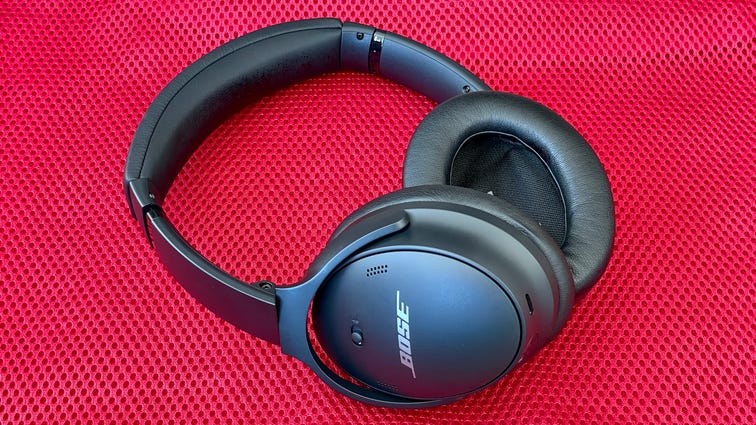

David Carnoy/CNET
The QuietComfort 45 has virtually the same design as its predecessor, the QuietComfort QC35 II, which many people considered one of the most comfortable over-ear headphones — if not the most comfortable. It has the same drivers, according to Bose, and the buttons are in the same place. However, there are small but notable changes. First off, these thankfully have USB-C instead of micro-USB.
Secondly, the microphone configuration is different. Not only have the mics been shifted on the headphones, but there’s now an extra external microphone for voice pick-up, which means the QC45 has a total of six microphones, four of which are beamforming and used for voice. By contrast, the QC35 II has a total of four, two of which are used for voice. (The Bose Noise Canceling Headphones 700 also have six microphones total.)
The end result is these are excellent for making calls. They’re similar to the Bose Headphones 700 in that regard and also feature top-notch noise canceling, as well as multipoint Bluetooth pairing so you can connect them with a PC and your phone simultaneously. Read our full review of the QuietComfort 45.

 \n ","topic":"","ttag":"","variant":"","viewguid":"","event":"listicle|image|2","correlationId":"","_destCat":"https:\/\/www.amazon.com\/Sony-WH-1000XM4-Canceling-Headphones-phone-call\/dp\/B0863TXGM3","productName":"Sony WH-1000XM4 (Black)","formatType":"IMAGE","location":"LIST","position":2,"sku":"WH1000XM4\/B","dwLinkTag":"article-body|listicle|image","selector":"#article-body #listicle-bd296839-72a9-4909-ad03-ee9da7d3f897 .itemImage"}}” rel=”noopener nofollow” target=”_blank”>
\n ","topic":"","ttag":"","variant":"","viewguid":"","event":"listicle|image|2","correlationId":"","_destCat":"https:\/\/www.amazon.com\/Sony-WH-1000XM4-Canceling-Headphones-phone-call\/dp\/B0863TXGM3","productName":"Sony WH-1000XM4 (Black)","formatType":"IMAGE","location":"LIST","position":2,"sku":"WH1000XM4\/B","dwLinkTag":"article-body|listicle|image","selector":"#article-body #listicle-bd296839-72a9-4909-ad03-ee9da7d3f897 .itemImage"}}” rel=”noopener nofollow” target=”_blank”>
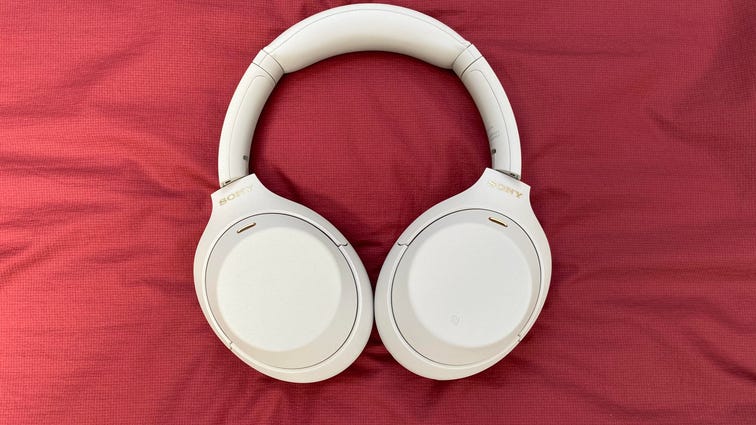

David Carnoy/CNET
Sony’s earlier WH-1000XM3 was a great noise-canceling headphone. But if it had a weakness, it was its voice-calling capabilities, particularly in noisier environments. The new WH-1000XM4 has improved in that area and also adds multipoint Bluetooth pairing so you can connect to two devices — such as your phone and PC — at the same time. That means that if a call comes in while you’re using the headphones with your computer the audio will switch to your phone when you answer the call.
The Bose Noise Cancelling Headphones 700 probably still have a slight edge for voice calls, but the 1000XM4 is arguably a tad more comfortable and also has some other slight improvements to its noise canceling and sound that makes it a great all-around choice for working from home.

 \n ","topic":"","ttag":"","variant":"","viewguid":"","event":"listicle|image|3","correlationId":"","_destCat":"https:\/\/www.amazon.com\/Bose-Cancelling-Wireless-Bluetooth-Headphones\/dp\/B07Q9MJKBV","productName":"Bose Noise Cancelling Headphones 700 (Black)","formatType":"IMAGE","location":"LIST","position":3,"sku":"794297-0100","dwLinkTag":"article-body|listicle|image","selector":"#article-body #listicle-e00a57ba-56de-460e-a777-191c0e012649 .itemImage"}}” rel=”noopener nofollow” target=”_blank”>
\n ","topic":"","ttag":"","variant":"","viewguid":"","event":"listicle|image|3","correlationId":"","_destCat":"https:\/\/www.amazon.com\/Bose-Cancelling-Wireless-Bluetooth-Headphones\/dp\/B07Q9MJKBV","productName":"Bose Noise Cancelling Headphones 700 (Black)","formatType":"IMAGE","location":"LIST","position":3,"sku":"794297-0100","dwLinkTag":"article-body|listicle|image","selector":"#article-body #listicle-e00a57ba-56de-460e-a777-191c0e012649 .itemImage"}}” rel=”noopener nofollow” target=”_blank”>
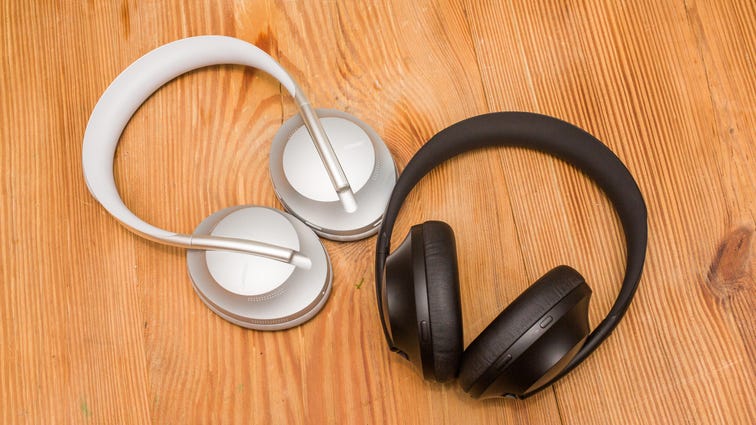

Sarah Tew/CNET
The Bose Noise Cancelling Headphones 700, the successor to Bose’s QuietComfort 35 II model — now replaced by the QuietComfort 45 — offer slightly better sound than the QuietComfort 45 and very good noise cancellation along with top-notch headset performance for voice calls (the QC45’s noise canceling is a touch better). They’re a strong all-around audio performer with up to 20 hours of battery life and a durable design. Some will find the QuietComfort 45 headphones slightly more comfortable, but the Headphones 700 has a more robust feature set, including the ability to adjust EQ and noise-canceling levels.
At launch, they cost $400, but they’ve recently come down in price. We’ve seen the white version dip as low as $299 while the black and silver versions have hit $340. That said, the Sony WH-1000XM4 headphones, their closest competitor, has also seen nice discounts.
They’re also now available in a UC version that includes a Bose USB Bluetooth link module for pre-pairing with PCs. That model — Bose Noise Cancelling Headphones 700 UC — is Microsoft Teams-certified.

 \n ","topic":"","ttag":"","variant":"","viewguid":"","event":"listicle|image|4","correlationId":"","_destCat":"https:\/\/www.amazon.com\/Poly-USB-Plantronics-Bluetooth-Compatible\/dp\/B092TFTF4P","productName":"Poly Voyager Focus 2 UC – headset – with charging stand","formatType":"IMAGE","location":"LIST","position":4,"sku":"213727-01","dwLinkTag":"article-body|listicle|image","selector":"#article-body #listicle-d505987b-e627-48e7-8e4e-4d63bb8cb910 .itemImage"}}” rel=”noopener nofollow” target=”_blank”>
\n ","topic":"","ttag":"","variant":"","viewguid":"","event":"listicle|image|4","correlationId":"","_destCat":"https:\/\/www.amazon.com\/Poly-USB-Plantronics-Bluetooth-Compatible\/dp\/B092TFTF4P","productName":"Poly Voyager Focus 2 UC – headset – with charging stand","formatType":"IMAGE","location":"LIST","position":4,"sku":"213727-01","dwLinkTag":"article-body|listicle|image","selector":"#article-body #listicle-d505987b-e627-48e7-8e4e-4d63bb8cb910 .itemImage"}}” rel=”noopener nofollow” target=”_blank”>
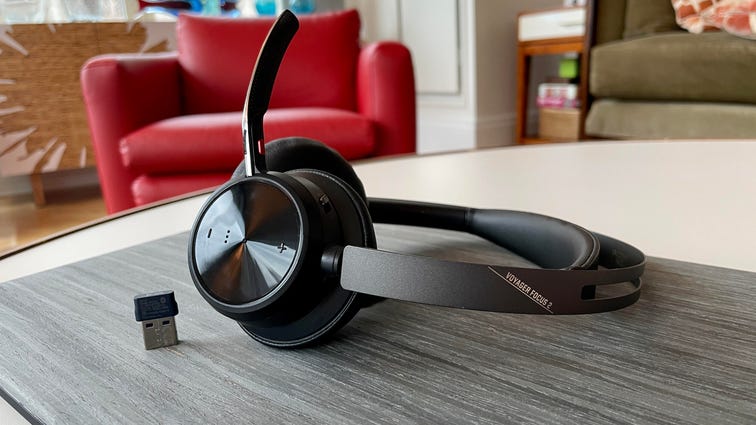

David Carnoy/CNET
Plantronics’ original Voyager Focus UC has long been considered one of the best work-from-anywhere headsets. Now we get the Voyager Focus 2 UC from Poly (the company Plantronics morphed into after it acquired Polycom), and it’s improved in several ways, including better noise reduction (it’s stellar), two levels of active noise canceling, increased battery life (up to 19 hours with ANC off and 16 hours with it on) and superior wireless range with Bluetooth 5.1.
You can pair the Voyager Focus 2 UC with your computer with the included USB dongle or your phone (or tablet) via Bluetooth. It can also connect to a desk phone if you want to bring it to the office. Also worth noting: The boom microphone has a mute button on it, but when you flip it up it also automatically mutes the microphone. The original Voyager Focus doesn’t mute when you lift the boom microphone.
The Focus 2 comes in several different versions, including USB-A and USB-C models and a version that’s Microsoft Teams certified. You can get the headset by itself or in a bundle that includes a charging dock. All versions include a nice protective carrying pouch.
The Voyager Focus 2 UC is expensive but offers excellent performance and is quite comfortable for an on-ear headphone. It also sounds good for music listening with nicely detailed sound and ample bass. It may not be quite up to the level of the Sony WH-1000XM4 for music, but it offers a nice music listening experience for a work-centric headset.
The original Voyager Focus UC (see below) can be had for closer to $150, so expect this next-gen to come down in price with time. I don’t know if it’s worth double the price, but it clearly performs better and has a swankier design than the original.

 \n ","topic":"","ttag":"","variant":"","viewguid":"","event":"listicle|image|5","correlationId":"","_destCat":"https:\/\/www.amazon.com\/dp\/B09JQMJHXY\/","productName":"Apple AirPods Pro","formatType":"IMAGE","location":"LIST","position":5,"sku":"MWP22AM\/A","dwLinkTag":"article-body|listicle|image","selector":"#article-body #listicle-b8e45760-aa10-40ae-9e20-0d3974d2c100 .itemImage"}}” rel=”noopener nofollow” target=”_blank”>
\n ","topic":"","ttag":"","variant":"","viewguid":"","event":"listicle|image|5","correlationId":"","_destCat":"https:\/\/www.amazon.com\/dp\/B09JQMJHXY\/","productName":"Apple AirPods Pro","formatType":"IMAGE","location":"LIST","position":5,"sku":"MWP22AM\/A","dwLinkTag":"article-body|listicle|image","selector":"#article-body #listicle-b8e45760-aa10-40ae-9e20-0d3974d2c100 .itemImage"}}” rel=”noopener nofollow” target=”_blank”>


Sarah Tew/CNET
Even if they don’t sound quite as magical as you’d hope a $249 model would (they often get discounted to $200, however), the Apple AirPods Pro still manage to be a great pair of true-wireless earphones with noise cancellation. That’s largely due to their winning design and fit, improved bass performance and effective noise canceling — and now they’ve been updated with spatial audio, a new virtual-sound mode for watching movies and TV shows (only works with iPhones and iPads running iOS 14), making it a terrific earbud for the money.
They feature excellent call quality, with good noise reduction and the ability to hear your voice in the buds as you talk. Their transparency mode is top notch (it lets you hear the outside world as if you weren’t wearing headphones) and Apple users should note that the AirPods Pro can easily switch between Apple devices so long as they’re all logged into the same iCloud account.

 \n ","topic":"","ttag":"","variant":"","viewguid":"","event":"listicle|image|6","correlationId":"","_destCat":"https:\/\/www.amazon.com\/dp\/B0865439LD\/","productName":"Jabra Elite 45h – headphones with mic","formatType":"IMAGE","location":"LIST","position":6,"sku":"100-91800000-02","dwLinkTag":"article-body|listicle|image","selector":"#article-body #listicle-f8c012d0-2d22-47bd-b4c2-8d45a5ec0063 .itemImage"}}” rel=”noopener nofollow” target=”_blank”>
\n ","topic":"","ttag":"","variant":"","viewguid":"","event":"listicle|image|6","correlationId":"","_destCat":"https:\/\/www.amazon.com\/dp\/B0865439LD\/","productName":"Jabra Elite 45h – headphones with mic","formatType":"IMAGE","location":"LIST","position":6,"sku":"100-91800000-02","dwLinkTag":"article-body|listicle|image","selector":"#article-body #listicle-f8c012d0-2d22-47bd-b4c2-8d45a5ec0063 .itemImage"}}” rel=”noopener nofollow” target=”_blank”>
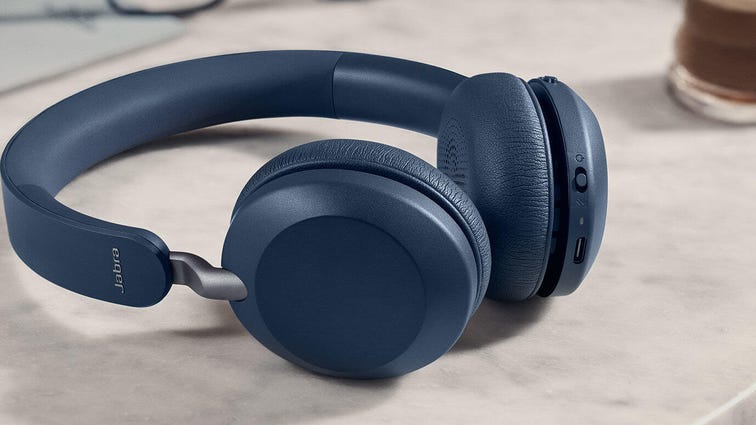

Jabra
Released in mid-2020, the Jabra Elite 45h were essentially billed as the best on-ear headphones for the money. While there’s nothing terribly fancy about them, they are among the best value on-ear headphones right now, with good sound quality, a sturdy design and comfortable fit — for on-ear headphones, anyway. They perform well as a headset for making calls too, and include a sidetone feature that allows you to hear your voice so you don’t talk too loudly. Battery life is also good and it has multipoint Bluetooth pairing so you can connect to both your computer and your smartphone at the same time, and easily switch between the two should a call come in on your phone. It mostly works.
Available in multiple color options, it lists for $100 but sporadically gets discounted to $70 and sometimes less; sometimes certain colors cost less than others.
Note that the $250 Evolve2 65, which has an integrated boom microphone, is essentially the souped-up office version of these headphones.

 \n ","topic":"","ttag":"","variant":"","viewguid":"","event":"listicle|image|7","correlationId":"","_destCat":"https:\/\/www.amazon.com\/dp\/B08DW2SJCQ\/","productName":"AfterShokz OpenComm – headset","formatType":"IMAGE","location":"LIST","position":7,"sku":"ASC100SG","dwLinkTag":"article-body|listicle|image","selector":"#article-body #listicle-a87332a4-84ee-48ff-81ee-9e6dff19cb38 .itemImage"}}” rel=”noopener nofollow” target=”_blank”>
\n ","topic":"","ttag":"","variant":"","viewguid":"","event":"listicle|image|7","correlationId":"","_destCat":"https:\/\/www.amazon.com\/dp\/B08DW2SJCQ\/","productName":"AfterShokz OpenComm – headset","formatType":"IMAGE","location":"LIST","position":7,"sku":"ASC100SG","dwLinkTag":"article-body|listicle|image","selector":"#article-body #listicle-a87332a4-84ee-48ff-81ee-9e6dff19cb38 .itemImage"}}” rel=”noopener nofollow” target=”_blank”>


David Carnoy/CNET
AfterShokz has turned its Aeropex bone-conduction headphones into a more communications-friendly headset with an integrated boom microphone. Since these leave your ears open (the sound is conducted through your cheekbone), they aren’t for people who want to seal their ears out from outside noise. Rather, the idea is that you can hear everything around you without having anything covering your ears or jammed inside them. Some folks find that liberating.
While AfterShokz are arguably the best-sounding bone-conduction headphones, they aren’t great-sounding for music because they’re lacking in the bass department. However, they’re great for speech so they work very well as a headset for making calls, with good noise reduction. These also have multipoint-Bluetooth pairing, so you can pair them with your phone and PC and easily switch to your phone if a call comes in while you’re on your computer. (Here are the instructions on how to use it.)
As long as you don’t mind the book microphone, you can use the OpenComm for sporting activities as well. The Aeropex and other AfterShokz headphones are favorites for runners who want to keep their ears open to hear the outside world for safety reasons. They’re also water-resistant. The only downside is they require a proprietary charging cable instead of USB-C. Battery life is rated at 16 hours of talk time and eight hours of listening time.

 \n ","topic":"","ttag":"","variant":"","viewguid":"","event":"listicle|image|8","correlationId":"","_destCat":"https:\/\/www.amazon.com\/dp\/B09674F2X6","productName":"JLab Audio Go Work – headset","formatType":"IMAGE","location":"LIST","position":8,"sku":"HBGOWORKRBLK4","dwLinkTag":"article-body|listicle|image","selector":"#article-body #listicle-db030440-48cb-45fe-9ab6-ba1227561423 .itemImage"}}” rel=”noopener nofollow” target=”_blank”>
\n ","topic":"","ttag":"","variant":"","viewguid":"","event":"listicle|image|8","correlationId":"","_destCat":"https:\/\/www.amazon.com\/dp\/B09674F2X6","productName":"JLab Audio Go Work – headset","formatType":"IMAGE","location":"LIST","position":8,"sku":"HBGOWORKRBLK4","dwLinkTag":"article-body|listicle|image","selector":"#article-body #listicle-db030440-48cb-45fe-9ab6-ba1227561423 .itemImage"}}” rel=”noopener nofollow” target=”_blank”>
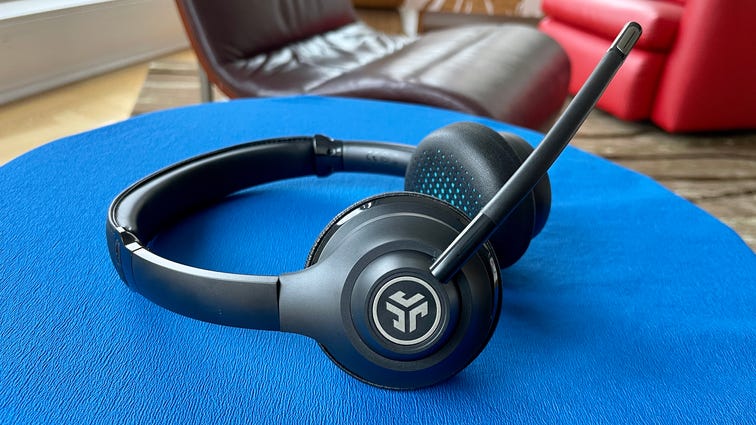

David Carnoy/CNET
Known for its value headphones and earbuds, JLab has released a pair of on-ear headphones with an integrated boom microphone (it can be rotated up when just listening to music) and multipoint Bluetooth pairing so you can connect them to your phone and computer simultaneously. I’m more partial to the Jabra Elite 45h, which list for $100 but usually sell for around $75. But if you don’t want to spend quite that much, the Go Work are solid headphones — and a good headset — for the modest price. They’re also comfortable to wear with a lightweight design. You won’t mistake these for premium headphones, but the build quality seems fine.
Battery life is rated at up to 45 hours at moderate volume levels, and you can mute calls using the multifunction button (an LED lights up at the end of the boom mic when the call is muted). I wouldn’t call the sound quality for music listening and the headset performance stellar, but it’s good, particularly for the price. For music listening, there’s ample bass and clarity and a cable is included for wired use. The headphones charge via USB-C.

 \n ","topic":"","ttag":"","variant":"","viewguid":"","event":"listicle|image|9","correlationId":"","_destCat":"https:\/\/www.amazon.com\/dp\/B08QRQMLVY\/","productName":"","formatType":"IMAGE","location":"LIST","position":9,"sku":"","dwLinkTag":"article-body|listicle|image","selector":"#article-body #listicle-968bb8b4-8d36-428d-b767-7c90cc640a6f .itemImage"}}” rel=”noopener nofollow” target=”_blank”>
\n ","topic":"","ttag":"","variant":"","viewguid":"","event":"listicle|image|9","correlationId":"","_destCat":"https:\/\/www.amazon.com\/dp\/B08QRQMLVY\/","productName":"","formatType":"IMAGE","location":"LIST","position":9,"sku":"","dwLinkTag":"article-body|listicle|image","selector":"#article-body #listicle-968bb8b4-8d36-428d-b767-7c90cc640a6f .itemImage"}}” rel=”noopener nofollow” target=”_blank”>
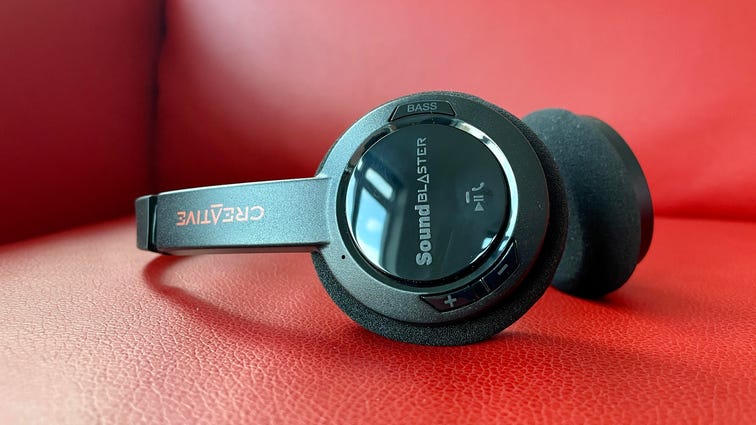

David Carnoy/CNET
I was a fan of Creative’s original Sound Blaster Jam headphones that came out in 2015 and had a decidedly retro look and feel, with good sound for the money. Now they’re available in a 2.0 version that has some key upgrades, including Bluetooth 5.0, USB-C charging, improved call quality and multipoint Bluetooth pairing that allows you to pair it to two devices simultaneously. Battery life is rated at up to 22 hours.
I was able to pair this wireless headphone set with a Mac Mini and an iPhone 12 Pro and then switch audio between them. Often when pairing Bluetooth headphones with Mac and Windows PCs, one can encounter some issues, but once I got the headphones paired with both my PC and phone, they made a good pair of work-from-home headphones. Also, the price is right for parents looking for a decent set of kids’ headphones for remote learning and everyday use.
Comfortable for on-ear headphones, the Jam V2s are lightweight and have nicely balanced sound with good detail and bass that’s ample but not overpowering. Call quality was good in my tests with callers saying they could hear me well even on the noisy streets of New York. No carry pouch is included, but you do get an extra set of foam ear pads, which is good, because they will wear out over time.
The headphones have physical buttons for controlling volume and playback, and there’s aptX support for devices that support the wireless streaming codec.

 \n ","topic":"","ttag":"","variant":"","viewguid":"","event":"listicle|image|10","correlationId":"","_destCat":"https:\/\/www.amazon.com\/New-Apple-AirPods-Max-Space\/dp\/B08PZHYWJS","productName":"Apple AirPods Max (Gray)","formatType":"IMAGE","location":"LIST","position":10,"sku":"MGYH3AM\/A","dwLinkTag":"article-body|listicle|image","selector":"#article-body #listicle-66ac5a1d-bd02-4ce0-b01e-9ad3eb04fba2 .itemImage"}}” rel=”noopener nofollow” target=”_blank”>
\n ","topic":"","ttag":"","variant":"","viewguid":"","event":"listicle|image|10","correlationId":"","_destCat":"https:\/\/www.amazon.com\/New-Apple-AirPods-Max-Space\/dp\/B08PZHYWJS","productName":"Apple AirPods Max (Gray)","formatType":"IMAGE","location":"LIST","position":10,"sku":"MGYH3AM\/A","dwLinkTag":"article-body|listicle|image","selector":"#article-body #listicle-66ac5a1d-bd02-4ce0-b01e-9ad3eb04fba2 .itemImage"}}” rel=”noopener nofollow” target=”_blank”>
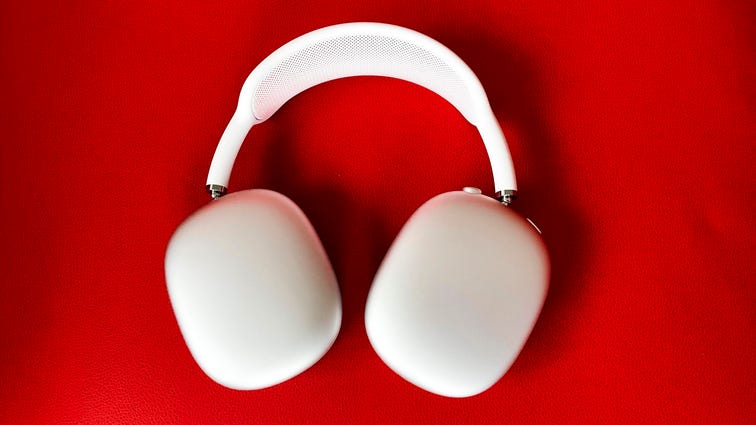

David Carnoy/CNET
Apple’s AirPods Max noise-canceling headphones cost a whopping $549. But if you’re an Apple-centric person who works on a MacBook and also has an iPhone (and maybe an iPad), like other AirPods, the Max allow you to easily connect to multiple Apple devices simultaneously (so long as you’re signed into your iCloud account on all the devices) and switch between them. If you’re on a Zoom teleconference and a call comes in on your iPhone, the AirPods Max automatically switch to the iPhone if you pick up the call.
They sound great, and with all their microphones they do an excellent job picking up your voice and reducing ambient noise. Aside from their high price, their other potential downside is their heavy weight. Although I found them comfortable, some people have trouble with that.

 \n ","topic":"","ttag":"","variant":"","viewguid":"","event":"listicle|image|11","correlationId":"","_destCat":"https:\/\/www.amazon.com\/dp\/B094C4VDJZ","productName":"Sony WF-1000XM4 (Black)","formatType":"IMAGE","location":"LIST","position":11,"sku":"WF1000XM4\/B","dwLinkTag":"article-body|listicle|image","selector":"#article-body #listicle-577921da-52fb-42f2-ba0f-7c418c53b4d0 .itemImage"}}” rel=”noopener nofollow” target=”_blank”>
\n ","topic":"","ttag":"","variant":"","viewguid":"","event":"listicle|image|11","correlationId":"","_destCat":"https:\/\/www.amazon.com\/dp\/B094C4VDJZ","productName":"Sony WF-1000XM4 (Black)","formatType":"IMAGE","location":"LIST","position":11,"sku":"WF1000XM4\/B","dwLinkTag":"article-body|listicle|image","selector":"#article-body #listicle-577921da-52fb-42f2-ba0f-7c418c53b4d0 .itemImage"}}” rel=”noopener nofollow” target=”_blank”>
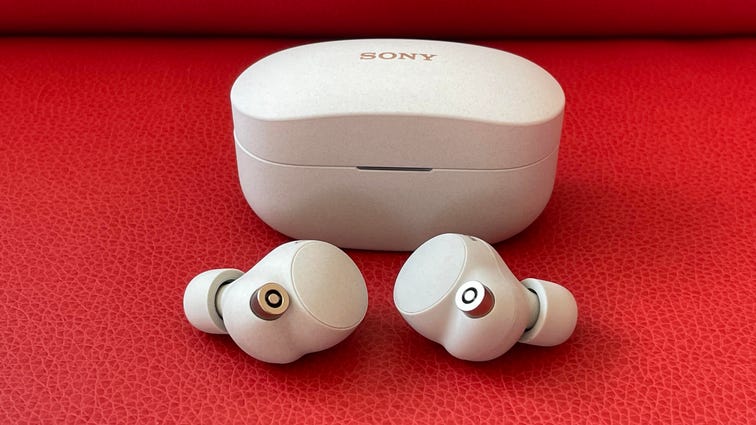

David Carnoy/CNET
No earbuds are perfect, of course, and not everybody will love the fit of the Sony WF-1000XM4 buds or be able to afford their high price. But if you’re looking for great-sounding earbuds with great noise canceling, solid voice-calling capabilities and good battery life, these buds check all the boxes.
Alas, they don’t feature multipoint Bluetooth like the over-ear WH-1000XM4 (it’s really their only missing feature), but their voice-calling capabilities have significantly improved. You can pair these with multiple devices but they won’t automatically switch between your PC and phone when a call comes in.

 \n ","topic":"","ttag":"","variant":"","viewguid":"","event":"listicle|image|12","correlationId":"","_destCat":"https:\/\/www.amazon.com\/dp\/B08WJRMW17\/","productName":"Jabra Evolve2 30 UC – headset","formatType":"IMAGE","location":"LIST","position":12,"sku":"23089-989-979","dwLinkTag":"article-body|listicle|image","selector":"#article-body #listicle-19bcc7c3-3dd8-440a-a2f2-e1ebc87d452d .itemImage"}}” rel=”noopener nofollow” target=”_blank”>
\n ","topic":"","ttag":"","variant":"","viewguid":"","event":"listicle|image|12","correlationId":"","_destCat":"https:\/\/www.amazon.com\/dp\/B08WJRMW17\/","productName":"Jabra Evolve2 30 UC – headset","formatType":"IMAGE","location":"LIST","position":12,"sku":"23089-989-979","dwLinkTag":"article-body|listicle|image","selector":"#article-body #listicle-19bcc7c3-3dd8-440a-a2f2-e1ebc87d452d .itemImage"}}” rel=”noopener nofollow” target=”_blank”>
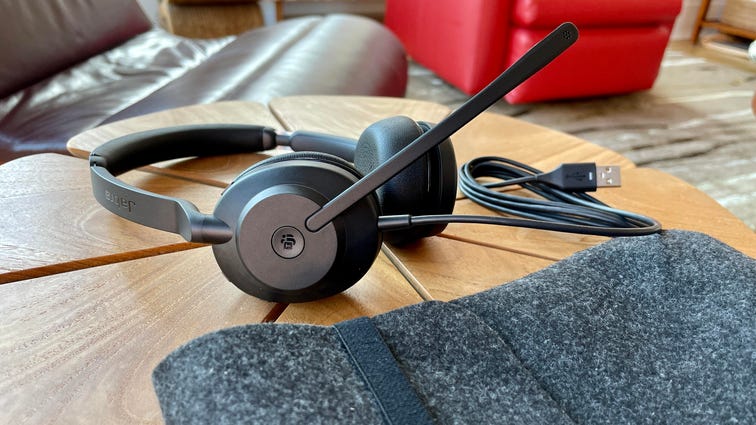

David Carnoy/CNET
Jabra recently released the Evolve2 30, a new more affordable wired on-ear office headset with an integrated boom microphone. It’s lightweight and comfortable and comes in USB-C and USB-A versions, as well as stereo and mono versions (I tried the USB-A stereo version). Alas, it’s hard to get at the moment — apparently, there’s plenty of demand for office headphones/headsets at this price point.
The headphones are OK for music listening but they’re primarily meant for voice applications. They feature dual microphones — one for picking up your voice and the other to help reduce ambient noise around you so callers can hear you better.

 \n ","topic":"","ttag":"","variant":"","viewguid":"","event":"listicle|image|13","correlationId":"","_destCat":"https:\/\/www.amazon.com\/dp\/B084S1CYKF\/","productName":"Shure Aonic 50 (Brown)","formatType":"IMAGE","location":"LIST","position":13,"sku":"SBH2350-BR","dwLinkTag":"article-body|listicle|image","selector":"#article-body #listicle-de0d6b4a-fb89-4baf-b725-f5c8958da266 .itemImage"}}” rel=”noopener nofollow” target=”_blank”>
\n ","topic":"","ttag":"","variant":"","viewguid":"","event":"listicle|image|13","correlationId":"","_destCat":"https:\/\/www.amazon.com\/dp\/B084S1CYKF\/","productName":"Shure Aonic 50 (Brown)","formatType":"IMAGE","location":"LIST","position":13,"sku":"SBH2350-BR","dwLinkTag":"article-body|listicle|image","selector":"#article-body #listicle-de0d6b4a-fb89-4baf-b725-f5c8958da266 .itemImage"}}” rel=”noopener nofollow” target=”_blank”>


Shure
If you’re looking for clean-sounding headphones with more of a neutral sound profile, the well-built Shure Aonic 50 is exactly that. The treble is clear and articulate and the bass is well-defined but may be a little underpowered for those who want a little more oomph. The noise canceling is good but not quite up to the level of top noise-canceling models from Bose and Sony that cost a little less.
The headphones fold flat but they’re a bit bulky, as is their case. But they work very well as a headset for making calls — Shure is known for making excellent microphones — so they’re good work-from-home headphones that are comfortable to wear, though they might be a little big for some folks.
While the Aonic 50 initially suffered from being a little too expensive (it started out at $400 but has now come down to as low as $250 for the brown version), they’re excellent headphones that seem built to last. Battery life is rated at 20 hours — they charge via USB-C — and they support a variety of audio codecs, including aptX, aptX HD, aptX Low Latency audio, Sony LDAC, AAC and SBC.

 \n ","topic":"","ttag":"","variant":"","viewguid":"","event":"listicle|image|14","correlationId":"","_destCat":"https:\/\/www.amazon.com\/dp\/B08B8XVBM6","productName":"Jabra Evolve2 85 UC Stereo – headset","formatType":"IMAGE","location":"LIST","position":14,"sku":"28599-989-999","dwLinkTag":"article-body|listicle|image","selector":"#article-body #listicle-bc403dd1-76a2-48d6-aa6b-0f451ea2e2e6 .itemImage"}}” rel=”noopener nofollow” target=”_blank”>
\n ","topic":"","ttag":"","variant":"","viewguid":"","event":"listicle|image|14","correlationId":"","_destCat":"https:\/\/www.amazon.com\/dp\/B08B8XVBM6","productName":"Jabra Evolve2 85 UC Stereo – headset","formatType":"IMAGE","location":"LIST","position":14,"sku":"28599-989-999","dwLinkTag":"article-body|listicle|image","selector":"#article-body #listicle-bc403dd1-76a2-48d6-aa6b-0f451ea2e2e6 .itemImage"}}” rel=”noopener nofollow” target=”_blank”>
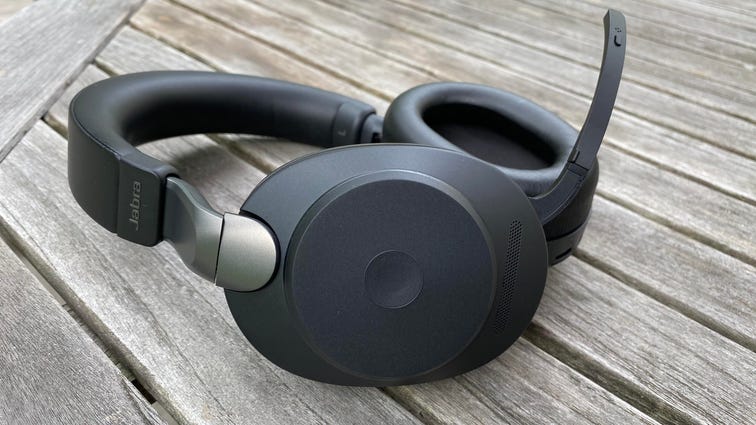

David Carnoy/CNET
If you’re looking for a souped-up version of the Elite 85h, the recently released Evolve2 85 offers even better telephony options along with a Unified Communications USB dongle for PCs. While it has similar sound quality to the 85h, it has an updated audio chipset, a hideaway boom arm and two additional microphones (10 altogether, with the extra two in the boom arm) for noise reduction and picking up your voice. Its build quality is also a step up. A Microsoft Teams-certified version is available for those who need it.
I found it comfortable to wear over several hours — it offers an impressive 37 hours of battery life or slightly more than the Elite 85h.
Downside: It lists for a whopping $449, though it sometimes sells for less.

 \n ","topic":"","ttag":"","variant":"","viewguid":"","event":"listicle|image|15","correlationId":"","_destCat":"https:\/\/amazon.com\/dp\/B08BN3T2NJ","productName":"EPOS I SENNHEISER ADAPT 660 – headset","formatType":"IMAGE","location":"LIST","position":15,"sku":"1000200","dwLinkTag":"article-body|listicle|image","selector":"#article-body #listicle-2cf59635-486a-4910-b976-d11f00dfba71 .itemImage"}}” rel=”noopener nofollow” target=”_blank”>
\n ","topic":"","ttag":"","variant":"","viewguid":"","event":"listicle|image|15","correlationId":"","_destCat":"https:\/\/amazon.com\/dp\/B08BN3T2NJ","productName":"EPOS I SENNHEISER ADAPT 660 – headset","formatType":"IMAGE","location":"LIST","position":15,"sku":"1000200","dwLinkTag":"article-body|listicle|image","selector":"#article-body #listicle-2cf59635-486a-4910-b976-d11f00dfba71 .itemImage"}}” rel=”noopener nofollow” target=”_blank”>
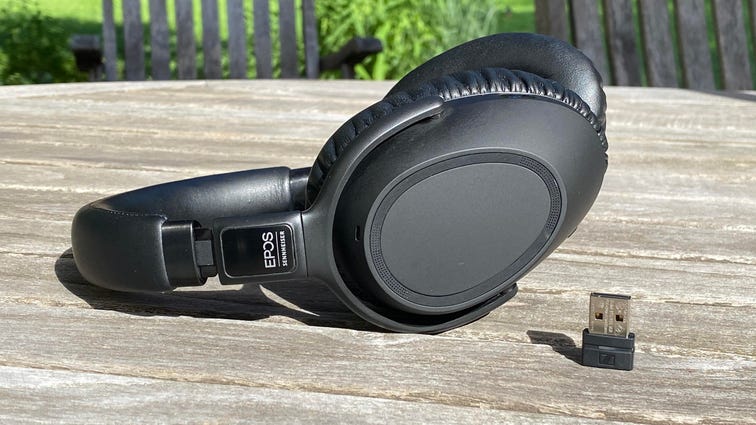

David Carnoy/CNET
This enterprise-level model from Epos is essentially a souped-up version of the Sennheiser PXC 550 with superior telephony and PC connectivity. It’s comfortable and has excellent noise-canceling. The voice performance is top-notch and it’s Microsoft Teams certified. Battery life is rated at 30 hours, which is very good.
The only downside is that it still uses Micro-USB instead of USB-C for charging (the new Sennheiser PXC 550 II has USB-C).
While its list price is $400, you can pick it up for less than $300.

 \n ","topic":"","ttag":"","variant":"","viewguid":"","event":"listicle|image|16","correlationId":"","_destCat":"https:\/\/www.amazon.com\/Bang-Olufsen-Beoplay-Comfortable-Headphones\/dp\/B08TZRP19J","productName":"Bang & Olufsen Beoplay HX – headphones with mic","formatType":"IMAGE","location":"LIST","position":16,"sku":"1224000","dwLinkTag":"article-body|listicle|image","selector":"#article-body #listicle-e535faba-e0c0-433b-9f06-e504ed4460d8 .itemImage"}}” rel=”noopener nofollow” target=”_blank”>
\n ","topic":"","ttag":"","variant":"","viewguid":"","event":"listicle|image|16","correlationId":"","_destCat":"https:\/\/www.amazon.com\/Bang-Olufsen-Beoplay-Comfortable-Headphones\/dp\/B08TZRP19J","productName":"Bang & Olufsen Beoplay HX – headphones with mic","formatType":"IMAGE","location":"LIST","position":16,"sku":"1224000","dwLinkTag":"article-body|listicle|image","selector":"#article-body #listicle-e535faba-e0c0-433b-9f06-e504ed4460d8 .itemImage"}}” rel=”noopener nofollow” target=”_blank”>


David Carnoy/CNET
Bang & Olufsen’s Beoplay HX is the successor to the company’s H9 series headphones (that X is a Roman numeral 10) and like those earlier H9 models, the HX carries a list price of $500 (some colors are discounted at Amazon). That price makes it a direct competitor with Apple’s AirPods Max, heavier headphones at 385 grams versus 285 grams for the HX. I don’t know if the HX is more comfortable than the AirPods Max, but I found the two models pretty equal in the comfort department over longer listening sessions and these do feature the usual swanky B&O lambskin covered memory foam ear pads.
The HX has custom 40mm drivers, Bluetooth 5.1 and support for Qualcomm’s aptX Adaptive (that includes AptX HD) for high-resolution wireless streaming when you combine an aptX-enabled Android device with certain music streaming services like Qobuz.
Their sound measures up well to the AirPods Max’s sound, with deep, well-defined bass, natural sounding mids (where vocals live) and inviting detail in the treble (the sound is overall well-balanced). If you want to push the treble or bass, you can tweak the EQ in the Bang & Olufsen app for iOS and Android and give the headphones a warmer or brighter profile.
While these are expensive, they offer more accurate sound than the Sony WH-1000XM4. Their noise canceling is also very good and voice-calling capabilities are also quite solid. Additionally, they offer multipoint Bluetooth pairing so you can connect them with a smartphone and PC simultaneously (aka Microsoft Swift Pair enabled for Windows machines) so you can easily switch between the two. (The Sony WH-1000XM4 also has this feature.) Battery life is rated at up to 35 hours with noise canceling on and 40 hours with it off. Those are excellent numbers.
Earlier Bang & Olufsen’s models included a soft case — a pouch really — but the HX comes with a hard case. As I said, it’s expensive, but the small improvements over earlier flagship Bang & Olufsen noise-canceling headphones help make the HX’s case as a worthy alternative to the AirPods Max.

 \n ","topic":"","ttag":"","variant":"","viewguid":"","event":"listicle|image|17","correlationId":"","_destCat":"https:\/\/www.amazon.com\/dp\/B08HR78C46\/","productName":"Jabra Elite 85t","formatType":"IMAGE","location":"LIST","position":17,"sku":"100-99190000-02","dwLinkTag":"article-body|listicle|image","selector":"#article-body #listicle-dd1bc266-2236-4f7e-82f1-fa2e80081d57 .itemImage"}}” rel=”noopener nofollow” target=”_blank”>
\n ","topic":"","ttag":"","variant":"","viewguid":"","event":"listicle|image|17","correlationId":"","_destCat":"https:\/\/www.amazon.com\/dp\/B08HR78C46\/","productName":"Jabra Elite 85t","formatType":"IMAGE","location":"LIST","position":17,"sku":"100-99190000-02","dwLinkTag":"article-body|listicle|image","selector":"#article-body #listicle-dd1bc266-2236-4f7e-82f1-fa2e80081d57 .itemImage"}}” rel=”noopener nofollow” target=”_blank”>
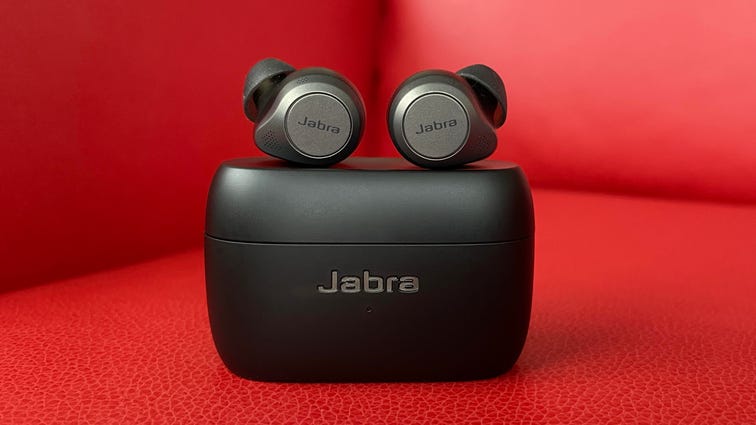

David Carnoy/CNET
Recently, Jabra announced its new Elite 7 Active and Elite 7 Pro earbuds, but the Elite 85t should stick around for a while and will hopefully be discounted. It’s a slightly bigger version of the 75t that features more powerful active noise canceling. Its new oval-shaped tips are designed to offer users a more comfortable fit, but the Elite 75t may actually be a better fit for some people’s ears.
The Elite 85t includes a wireless charging case (it’s a $20 upgrade for the Elite 75t), larger 12mm drivers for improved sound and six-microphone technology — three on each ear, two on the outside, one on the inside — for improved voice calling with better noise reduction (four of the microphone are used for active noise canceling).
Like the Elite 75t (and new Elite 7 Active and Elite 7 Pro), these earbuds feature multipoint Bluetooth pairing so you can pair them with your phone and computer at the same time (and take calls with your phone when they come in). They’re IPX4 splash-resistant and deliver five and a half hours of battery life with noise canceling on and seven hours with it off. Read our Jabra Elite 85t review.

 \n ","topic":"","ttag":"","variant":"","viewguid":"","event":"listicle|image|18","correlationId":"","_destCat":"https:\/\/www.bestbuy.com\/site\/microsoft-surface-headphones-2-wireless-noise-cancelling-over-the-ear-with-cortana-matte-black\/6408622.p?skuId=6408622","productName":"Microsoft Surface Headphones 2 (Black)","formatType":"IMAGE","location":"LIST","position":18,"sku":"QXL-00009","dwLinkTag":"article-body|listicle|image","selector":"#article-body #listicle-e4539022-5f9f-48e1-be8f-e2158ccc0d60 .itemImage"}}” rel=”noopener nofollow” target=”_blank”>
\n ","topic":"","ttag":"","variant":"","viewguid":"","event":"listicle|image|18","correlationId":"","_destCat":"https:\/\/www.bestbuy.com\/site\/microsoft-surface-headphones-2-wireless-noise-cancelling-over-the-ear-with-cortana-matte-black\/6408622.p?skuId=6408622","productName":"Microsoft Surface Headphones 2 (Black)","formatType":"IMAGE","location":"LIST","position":18,"sku":"QXL-00009","dwLinkTag":"article-body|listicle|image","selector":"#article-body #listicle-e4539022-5f9f-48e1-be8f-e2158ccc0d60 .itemImage"}}” rel=”noopener nofollow” target=”_blank”>


David Carnoy/CNET
Microsoft’s over-ear noise-canceling Surface Headphones 2 were released earlier in 2020, and the biggest change from their predecessor is the price: The original Surface Headphones launched at $350, while the Headphones 2 cost $250. Like the original, there’s a lot to like about this second-gen model. While they’ve lost their hands-free Cortana voice-control feature (a change no one will lament) and the sound quality hasn’t improved (it’s quite good but not stellar), the combination of some small design tweaks, better battery life, upgraded Bluetooth and the new lower price help bump their rating up and make them more recommendable.
Their multipoint Bluetooth pairing capability allows you to pair them with two devices at the same time (such as a computer and phone) and quickly switch the audio from each device to the headphones. That’s an appealing feature from a work-from-home standpoint, and these also work well for making voice calls on your phone.

 \n ","topic":"","ttag":"","variant":"","viewguid":"","event":"listicle|image|19","correlationId":"","_destCat":"https:\/\/www.amazon.com\/Logitech-Zone-Wireless-Bluetooth-Headset\/dp\/B07PS1Q6Z8","productName":"Logitech Zone Wireless","formatType":"IMAGE","location":"LIST","position":19,"sku":"981-000797","dwLinkTag":"article-body|listicle|image","selector":"#article-body #listicle-afbe95c9-7f40-4cc2-97a0-1e6c5fb10d28 .itemImage"}}” rel=”noopener nofollow” target=”_blank”>
\n ","topic":"","ttag":"","variant":"","viewguid":"","event":"listicle|image|19","correlationId":"","_destCat":"https:\/\/www.amazon.com\/Logitech-Zone-Wireless-Bluetooth-Headset\/dp\/B07PS1Q6Z8","productName":"Logitech Zone Wireless","formatType":"IMAGE","location":"LIST","position":19,"sku":"981-000797","dwLinkTag":"article-body|listicle|image","selector":"#article-body #listicle-afbe95c9-7f40-4cc2-97a0-1e6c5fb10d28 .itemImage"}}” rel=”noopener nofollow” target=”_blank”>
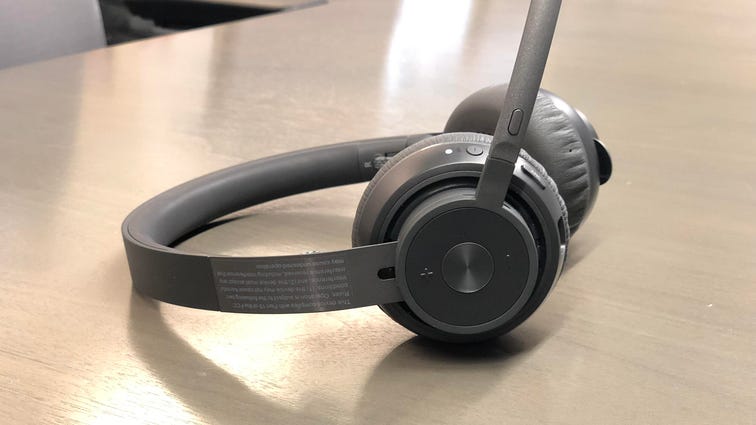

David Carnoy/CNET
While Logitech calls its Zone Wireless a headset, they’re really on-ear active noise-canceling headphones with an integrated boom mic. What makes them unique is that you can set them on a Qi wireless charging pad to juice up their battery, which is rated for up to 15 hours of battery life talk time or music listening. The headset also charges via Micro-USB.
I found them to be a comfortable fit, especially for on-ear headphones, and they’re great for making calls, with a sidetone feature that lets you hear your voice inside the headset so you don’t speak too loudly while having conversations. The only drawback is that the headset sounds just OK for music and audio listening, not great. While they’re not really meant to be mobile headphones, you can walk around with them on just fine and their multidevice pairing feature allows you to easily switch between your phone and a computer.

 \n ","topic":"","ttag":"","variant":"","viewguid":"","event":"listicle|image|20","correlationId":"","_destCat":"https:\/\/www.amazon.com\/Bluetooth-Wireless-Cancelling-Charging-Resistant\/dp\/B08MWZHHKP","productName":"Samsung Galaxy Buds Pro (Black)","formatType":"IMAGE","location":"LIST","position":20,"sku":"SM-R190NZKAXAR","dwLinkTag":"article-body|listicle|image","selector":"#article-body #listicle-126b4809-f37f-4e9f-8302-5682e3b951a0 .itemImage"}}” rel=”noopener nofollow” target=”_blank”>
\n ","topic":"","ttag":"","variant":"","viewguid":"","event":"listicle|image|20","correlationId":"","_destCat":"https:\/\/www.amazon.com\/Bluetooth-Wireless-Cancelling-Charging-Resistant\/dp\/B08MWZHHKP","productName":"Samsung Galaxy Buds Pro (Black)","formatType":"IMAGE","location":"LIST","position":20,"sku":"SM-R190NZKAXAR","dwLinkTag":"article-body|listicle|image","selector":"#article-body #listicle-126b4809-f37f-4e9f-8302-5682e3b951a0 .itemImage"}}” rel=”noopener nofollow” target=”_blank”>
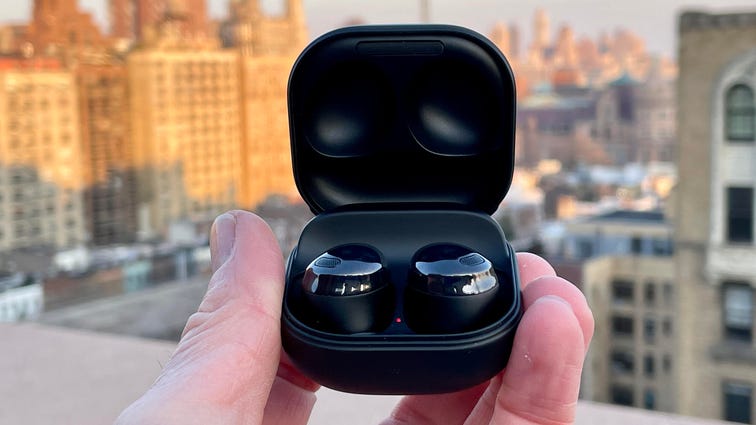

David Carnoy/CNET
Samsung’s Galaxy Buds Pro are slightly superior to the new, slightly more affordable Galaxy Buds 2 — at least when it comes to sound, noise-canceling performance and water-resistance (they’re fully waterproof). They also have a couple of features missing from the Buds 2, including Samsung’s new 360 Audio virtual surround feature that’s similar to Apple’s spatial audio (360 Audio only works with certain Galaxy devices, but the list is growing).
The Buds Pro are mostly impressive, although just how good you think they are will ultimately depend on how well they fit your ears. For some people, the smaller Galaxy Buds 2 will be the better fit — and better choice.
The Buds Pro performed very well in my voice-calling tests. Samsung says they have three microphones, plus a Voice Pickup Unit, and they’re equipped with noise-reduction technology that helps eliminate wind noise in particular. Callers said my voice sounded a touch clearer when I was using the AirPods Pro, but the noise reduction was good with the Buds Pro and people said they could hear me well even in fairly noisy environments. Like the Galaxy Buds Plus, while they easily switch between Samsung Galaxy devices, they don’t have true multipoint Bluetooth pairing (for connecting to two devices simultaneously). However, they do include Microsoft’s Swift Pair feature, which allows to more easily pair them to a Windows 10-based PC.

 \n ","topic":"","ttag":"","variant":"","viewguid":"","event":"listicle|image|21","correlationId":"","_destCat":"https:\/\/www.amazon.com\/Plantronics-Bluetooth-USB-Compatible-Canceling-Works\/dp\/B013F4LLZ0","productName":"Plantronics Voyager Focus UC (B825 Standard)","formatType":"IMAGE","location":"LIST","position":21,"sku":"202652-01","dwLinkTag":"article-body|listicle|image","selector":"#article-body #listicle-2f908e29-22fc-43fd-986d-f7f1858d46fa .itemImage"}}” rel=”noopener nofollow” target=”_blank”>
\n ","topic":"","ttag":"","variant":"","viewguid":"","event":"listicle|image|21","correlationId":"","_destCat":"https:\/\/www.amazon.com\/Plantronics-Bluetooth-USB-Compatible-Canceling-Works\/dp\/B013F4LLZ0","productName":"Plantronics Voyager Focus UC (B825 Standard)","formatType":"IMAGE","location":"LIST","position":21,"sku":"202652-01","dwLinkTag":"article-body|listicle|image","selector":"#article-body #listicle-2f908e29-22fc-43fd-986d-f7f1858d46fa .itemImage"}}” rel=”noopener nofollow” target=”_blank”>


Amazon
An oldie but goodie, the Plantronics Voyager Focus UC allows you to switch between a Bluetooth connection on a smartphone or tablet and a computer. These are lightweight, comfortable on-ear headphones that have excellent noise reduction and a retractable boom microphone so people have no problem hearing your voice, and you can hear your voice in the headphones.

 \n ","topic":"","ttag":"","variant":"","viewguid":"","event":"listicle|image|22","correlationId":"","_destCat":"https:\/\/www.amazon.com\/dp\/B07Q1HXCQP","productName":"Jabra Evolve 65e UC – earphones with mic","formatType":"IMAGE","location":"LIST","position":22,"sku":"6599-629-109","dwLinkTag":"article-body|listicle|image","selector":"#article-body #listicle-bf35e7ed-6113-4e91-9acc-4053a7d2d927 .itemImage"}}” rel=”noopener nofollow” target=”_blank”>
\n ","topic":"","ttag":"","variant":"","viewguid":"","event":"listicle|image|22","correlationId":"","_destCat":"https:\/\/www.amazon.com\/dp\/B07Q1HXCQP","productName":"Jabra Evolve 65e UC – earphones with mic","formatType":"IMAGE","location":"LIST","position":22,"sku":"6599-629-109","dwLinkTag":"article-body|listicle|image","selector":"#article-body #listicle-bf35e7ed-6113-4e91-9acc-4053a7d2d927 .itemImage"}}” rel=”noopener nofollow” target=”_blank”>
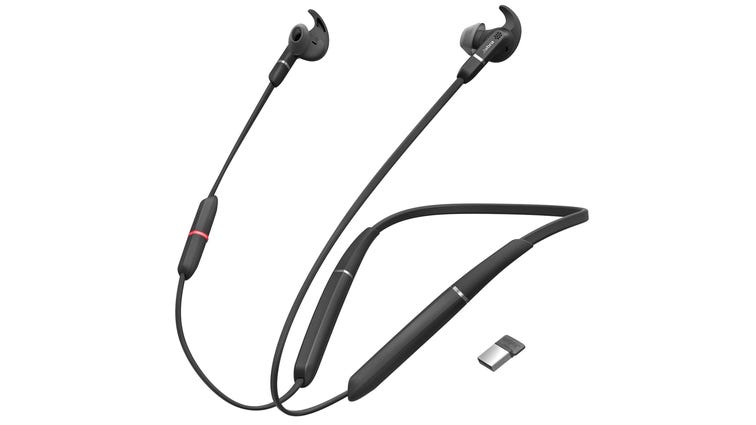

Jabra
Jabra’s Evolve 65e UC is an around-the-neck model that offers a comfortable, secure fit. You get three sizes of stabilizing fins along with three sizes of ear tips. This version is Skype for Business and UC certified and the included USB Bluetooth adapter allows you to be connected to your PC (Windows or Mac) at the same time as your smartphone.
While these headphones are decent for music listening — they’re a little shy on the bass — they excel as a headset for making phone calls, with good noise reduction, especially wind noise. The integrated inline microphone sits close to your mouth so people have no problem hearing you. Battery life is rated at 13 hours.
Note that this is the business-grade version of the Elite 65e. Jabra also makes the step up Evolve 75e UC that costs about $50 more and features active noise canceling. I didn’t think the noise canceling was great, however, so it’s probably best to save the money and get the 65e UC.
